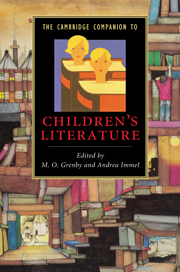Book contents
- Frontmatter
- Part I Contexts and Genres
- 1 The origins of children’s literature
- 2 Children’s books and constructions of childhood
- 3 The making of children’s books
- 4 Picture-book worlds and ways of seeing
- 5 The fear of poetry
- 6 Retelling stories across time and cultures
- 7 Classics and canons
- Part II Audiences
- Part III Forms and Themes
- Further reading
- Index
4 - Picture-book worlds and ways of seeing
from Part I - Contexts and Genres
Published online by Cambridge University Press: 28 November 2010
- Frontmatter
- Part I Contexts and Genres
- 1 The origins of children’s literature
- 2 Children’s books and constructions of childhood
- 3 The making of children’s books
- 4 Picture-book worlds and ways of seeing
- 5 The fear of poetry
- 6 Retelling stories across time and cultures
- 7 Classics and canons
- Part II Audiences
- Part III Forms and Themes
- Further reading
- Index
Summary
The world in images
When adults look back on their lives, Virginia Woolf argues in The Waves (1931), they 'turn over these scenes as children turn over the pages of a picturebook'. Memories of childhood may become indelibly linked to early memories - visual, tactile, spatial - of reading picture books, whose 'picture worlds' may permanently shape readers' worldview. Since the Enlightenment, illustrated books have aimed to teach children how to read, apprehend and make sense of the world. This chapter describes how an emerging picture-book tradition developed particular visual conventions, working both to initiate children into this tradition and to push them into autonomous seeing.
Precisely because of its ambitions to represent the world itself, the picture book frequently understands itself as a Gesamtkunstwerk (a work integrating multiple art forms and appealing to multiple senses), and hence reflecting more general trends in visual, literary and intellectual culture. Unlike other forms of children's literature, the picture book makes meaning largely through its visual format, the way its images relate to one another, to the verbal text, and to the space on (and physical layout of) the page. This chapter, accordingly, traces the history of several influential and enduring picture-book formats.
- Type
- Chapter
- Information
- The Cambridge Companion to Children's Literature , pp. 55 - 75Publisher: Cambridge University PressPrint publication year: 2009
- 3
- Cited by

